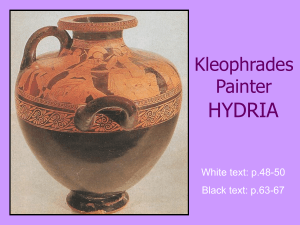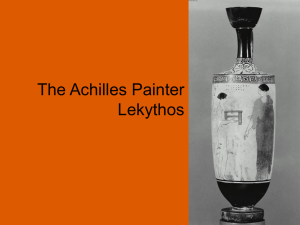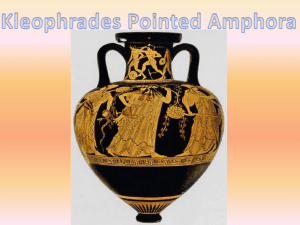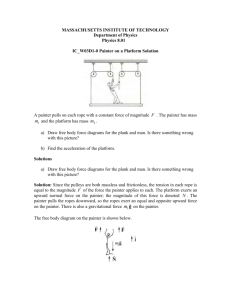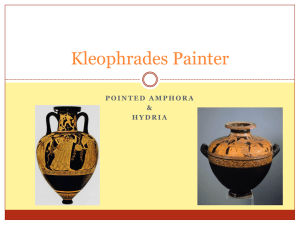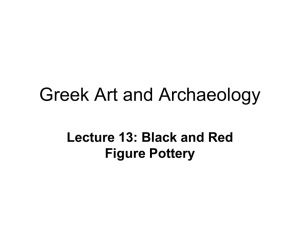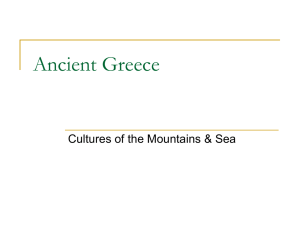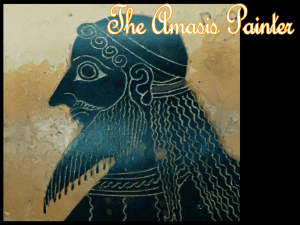Kleophrades Painter Hydria
advertisement
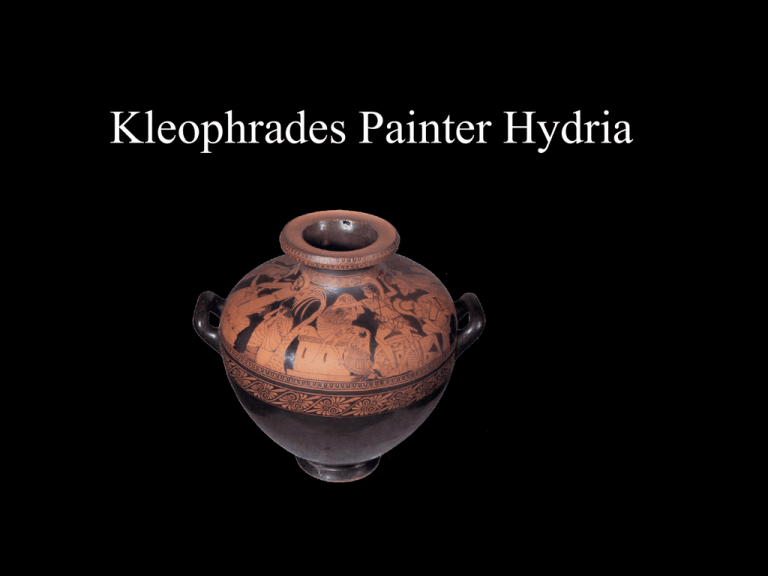
Kleophrades Painter Hydria • • • • Was made between 500—480BC. Is approximately 42cm in height. Potter: Kleophrades Painter: ‘Kleophrades Painter’ • The Kleophrades painter remained anonymous for a long time, even being falsely identified as the painter Epiktetos. He is thought to be the son of potter Amasis and the pupil of Euthymides, as his a good deal of his early work greatly implies. The Kleophrades painter had disciples himself, including the Berlin Painter and the Boot Painter. Overall the Kleophrades painter is recognized as one of the greatest pot painters in the late Archaic period in Athens. • The Kleophrades Painter Hydria was used for carrying water. It has three handles. • The red figure technique was employed. • The vase shape is perfect for carrying, storing and pouring water. • Hydria shape. • The scenes that encircle the vase depict the sacking of Troy, the rape of Cassandra, Aeneas’ escape from his father from whence he shall found a new Troy. The Greeks are illustrated to be savage and barbaric, showing no remorse (ironically painted whilst Athens was in the process of falling to ruin) • Side A Overview: • New advances on spatial representation as the ornamentation is all painted around the neck and shoud\lder of the vase. • There is an increase in the overlapping of figures present. • The Kleophrades Painter has employed the three quarter technique to give a unique perspective of the inside of the warrior’s shield while his left thigh and foot have been foreshortened in their frontal pose… again, the proportions are not perfect. • To the far right of this pair is a triangle-shaped assemble intentionally removed from the warzone so that it appears to join in both halves of the narrative together. • The two armed and bearded soldiers are contrasted to the vulnerable old woman frightened on the ground. • Side B Overview • The Kleophrades Painter has again decided to foreshortening when painting Cassandra’s leg. • Aeneas is painted from the rear view and beside him is his young son Ascanius. The Rape of Cassandra • The rape of Cassandra by Ajax, a Greek warrior, son of Oileus. He steps over a Trojan soldier whom is already dead by his hand. To their right is a statue of Athena Palladium, from which Cassandra is attached to, seeking strength and hope as Ajax nears her. • SIDE B • Aeneas Flees the Devastated City of Troy • Aeneas is the middle figure whose back is facing us: he is supporting the weight of his elderly father Anchises. To Aeneas’ left is a smaller man, his son Ascanius, who rather than be depicted as a child, Kleophrades has chosen to paint him as a young adult. Interesting to note is how both Aeneas’ father and son seem to be looking back from whence they came, as in fear of the massacre the Greeks were inflicting upon Troy’s walls. • The next scene shows two women crouching, their heads down and positions defensive. One woman is underneath a heavily bent palm tree (battered to represent the destruction that was occurring) and gripping her hair out in fit of anguish. The second Trojan woman sits opposite, also horrified, behind her a statue of Athena (called the Palladium, considered the most sacred item in Troy). The Sack of Troy and Death of Priam • The scene: The blood-splattered King Priam sits on the altar, the limp corpse of his grandson Astyanax, son of Hector, laid across his lap. Priam is depicted as an elderly gentleman with a bald head and a considerable 5’o clock shadow. He cowers his head with his hands in a futile gesture to ward off the fatal blow inevitably coming from Neoptolemus, son of Achilles. Unusually Neoptolemus has been presented from the rear with his head and left leg in profile. He is dressed in full battle armour, posed with his huge sword, called the Machaira. The Kleophrades Painter has gone into considerable detail when painting his armour. A dead Trojan soldier lies at his feet, a disturbing presence. The painter is illustrating the immense cruelty that took place in Troy, not hesitating to include gore in his depictions of slaughter. The Heroism of a Trojan Woman • An armed Greek warrior crouches behind his shield as he is attacked by a furious Trojan woman with a large pestle or a chair leg, the use of a domestic object suggesting she is desperate, but courageous. The painter has used the threequarter technique to give a viewpoint of the inside of the warrior’s shield, in which the painter has gone into elaborate detail. • The courage of an everyday Trojan woman against a trained and likely highly skilled soldier is emphasized by the choice to have her towering over him, standing taller and showing no mercy, which conveys one of the many moods of the vase effectively at this juncture. Composition • Scene painted on the double curve of the shoulder and the neck of the vase (Death of Priam and the sack of Troy) • This is quite a difficult surface to paint on, reflecting his interests in triangles. • Shape of the vase = individual scenes are organised in triangles, which are framed by positions of bodies or objects such as trees or statues. • Each group is self contained, however links to the overall theme of the vase and has links to all other scenes. • The two ends of the frieze both show shields. Also, both end scenes are linked thematically by hope, courage and liberation from the horror of war. Innovations • The Kleophrades Painter continued to use incision in his paintings, most often to detail hair but also to highlight other features of the figures involved. • A wide variety of poses were used, and new perspectives of armour and shields offered a more in depth insight into the warzone. • He was also innovative when painting realistic facial features such as facial hair; eyes were painted open at the inner corner with pupils painted forward, rather than the common frontal eyes in a profile face. • A full S-curve was used for the nostrils and he outlined the lips to give the effect of making them appear fuller. • Stylistically, Kleophrades’ vases were luxurious and had clear composition. Regarded as one of the best red-figure decorators, he sometimes painted in blackfigure, but was a follower of red-figure decorators (the Pioneer group). He shared their interests in innovations and vase decoration.
